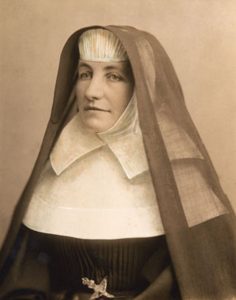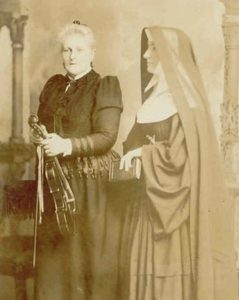Founder of the First Convent of Mercy on the west coast of Newfoundland
What you can plan is too small for you to live…1

Sister Mary Antonio Egan, the founder of the first Convent of Mercy on Newfoundland’s west coast, would have undoubtedly nodded in agreement at poet David Whyte’s wise comment on life. The call of the mission in the late nineteenth century took her from the comfortable academic and cultural milieu of convent life and ministry in Providence, Rhode Island, to a foreign, harsh environment with very rudimentary educational and social structures. It was in this environment of hardship and struggle in Bay St. George, Newfoundland, that Sister Mary Antonio and her companions gave birth to a dream that would change their lives and the lives of all who were touched by their ministry of Mercy.
The French Treaty Shore
The west coast of Newfoundland had long suffered the effects of the so-called “French Treaty Shore.” The Treaty of Utrecht, ratified by Britain and France in 1713 and confirmed by various treaties thereafter, allowed the French to fish in season on the coast of between Cape Bonavista and Point Riche. Over the years, disagreements and conflicts often arose between the Newfoundland and the French fishermen, largely due to different interpretations of the various treaties. These disputes inevitably interfered with the settlement and development of a large section of the island. When the boundaries of the French Shore were changed by the Treaty of Versailles in 1783 to include the whole area from Cape St. John on the northeastern tip of the Baie Verte peninsula to Cape Ray on the southwest corner of the island, Bay St. George became part of the French Shore.
For much of the nineteenth century, settlers on the French Shore were under constant threat of aggression and unfair competition. Bishop Howley, writing in the latter part of the century, deemed the fishing/curing rights conceded by Britain and France in the various treaties to be unjust to the people of Newfoundland. In his words, these rights were… an endless source of bickering and discontent between the fishermen of France and the inhabitants of the Island of Newfoundland and a heavy clog upon the progress of the colony.2
These conditions prevailed until 1904, when Britain and France resolved many of their long-standing disputes, and France finally agreed that the fishing clauses of the old treaties should be revoked.
In the first half of the nineteenth century, with the arrival of the Acadians from Cape Breton, Bay St. George had become a focal area of French settlement. By mid-century, its main settlement, Pointe-de-Sable or Sandy Point, was recognized as the commercial and religious center of the whole west coast. Father Alexis Belanger, the first resident priest on the west coast, made his home in Sandy Point from 1850 to his death in 1868, devoting most of his time and attention to that settlement.3
The Dream Expressed
Western Newfoundland was attached to the St. John’s diocese until 1870, when it was constituted a Prefecture Apostolic and Father Thomas Sears was named Prefect Apostolic.4 As early as 1873 in a report to the Society for the Propagation of the Faith, Father Sears expressed his dream of having a community of nuns to educate the young women of his parish”, which then comprised most of the west coast. He wrote:
Could we afford to establish a good seminary of Instruction for females as the first beginning we would gain much. A convent of five or six well-educated nuns would be of the greatest importance…5

Father Sears’ dream would come to fruition some twenty years later in a marvellous chain of events that could only be seen as the providence of God at work.
It was Father Sears’ successor and friend, Reverend Michael Francis Howley, who would bring a community of nuns to Newfoundland’s west coast. A highly intelligent, energetic and visionary man, Michael Francis Howley became Prefect Apostolic of the west coast of the island in 1885, Sandy Point being the seat of the Prefecture. Full of ideas and zeal for the advancement of his extensive mission, Bishop Howley realized that his starting point and focus had to be the promotion of education and religion throughout the area. Like his predecessor, Father Sears, he saw the importance of a community of Sisters to help him carry out his missionary goals.
Relationships Forged
Meanwhile, in another part of the world, events were unfolding that would give life to a long-held dream and change the lives of many in the process. On a riverboat in Massachusetts, sometime in the mid 1880s, a wealthy and well-travelled American woman, Mrs. Henrietta Brownell, met Sister M. Juliana Purcell, a Sister of Mercy from St. Xavier’s Convent in Providence, Rhode Island. Sometime later, the chance finding of a medal of the Virgin Mary by Mrs. Brownell led her to St. Xavier’s, a circumstance that forged relationships which would profoundly affect the lives of all concerned. A lasting friendship developed between Mrs. Brownell and Sister Juliana, and indeed the whole St. Xavier’s community welcomed Mrs. Brownell as friend and benefactor.

Henrietta Knowlton Brownell was born in Bristol, Rhode Island in 1837. Her first husband, George A. Pierce, died sometime in the early 1860s. When the Sisters of Mercy met Henrietta, she was the wife of Charles De Wolf Brownell, a lawyer and a renowned landscape artist. From her first marriage, she had two children, a boy and a girl, and the Brownells had four sons. The family travelled extensively, with Mr. Brownell devoting himself to painting his landscapes. Henrietta was a very talented lady, a writer and an accomplished musician with a proficiency in piano and violin. In gratitude to the sisters at St. Xavier’s for their kindness to her, she offered to teach violin to any of them who desired to learn, and with the permission of the local superior, a number of the sisters took lessons. This brought Mrs. Brownell into frequent contact with the sisters, and over time she developed a close relationship with another community member of St. Xavier’s, Sister Mary Antonio Egan.
After Mrs. Brownell converted to Catholicism in the late 1880s, she made the decision to use some of her wealth to finance the establishment of a convent in a missionary country. She discussed her plans with Sisters Juliana and Antonio, who shared her enthusiasm for such a worthy venture. When Sister Juliana died in 1888, Sister M. Antonio became her main confidante and advisor.
Early Life of the Founder
Sister Mary Antonio, born Elizabeth Egan in England on May 12, 1852, came with her father, brothers and sister to the United States at an early age to live with an aunt. She attended St. Xavier’s Convent School, a private school begun by the Sisters of Mercy in Providence in 1856. She entered the community at St. Xavier’s in May, 1868 and was professed on January 1, 1871.
In The Leaves of the Annals of the Sisters of Mercy we read that she was one of the Sisters who devotedly nursed a pioneer Sister in Providence in her last illness.6 This reference, brief though it is, indicates the spirit of mercy and compassion that characterized Sister Antonio throughout her life and ministry.
Sister Antonio was entrusted with many responsibilities in the Congregation and was said to have been extremely gifted as a teacher and administrator. She was elected Superior of St. Xavier’s at the Chapter of 1866, but she declined the office.7 Another Chapter was held at St Xavier’s in July 1888, and Sister Antonio was again elected Superior. This time, she was prepared to assume the responsibility, but Bishop Matthew Harkins, who presided at the Chapter of Elections, refused to accept her.8 Three separate votes were held, with Sister Antonio receiving the majority each time. However, the Bishop was inflexible in his decision and instead appointed Sister Mary Mechtilde Brennan as Superior. In his record of events, he stated that Sister Mary Antonio “was certainly unqualified for the office of Superior.” In the same notes he writes of her close friendship with Mrs. Brownell, the negative impact it had on the discharge of her duties, the efforts of superiors to discourage this friendship and Sister Antonio’s persistence in maintaining it.9 This situation seems to have been at the heart of Bishop Harkins’ refusal to confirm Sister Antonio’s election.
Up to the second half of the twentieth century, all aspects of convent life were highly regulated, and the ideal sister was one who followed the Rule in every respect. In the area of relationships, the good religious was expected to be charitable to all but emotionally detached from everyone. Thus, relationship as an essential component of human life and growth, was neglected or ignored to the detriment of the Sister herself, her community, her family, her colleagues and associates. In such a closed milieu, friendship or any close relationship was practically impossible, and was almost viewed as an aberration.
Although the bishop and the Superiors of the Providence community were following the norms of the day regarding the election process, they probably overreacted in Sister M. Antonio’s case; on the other hand, the cloud of suspicion and mistrust that covered Sister Antonio likely caused her to turn even more towards the friendship and support offered Mrs. Brownell.10 This troubling set of circumstances brought untold distress and anguish to those on both sides of the situation.
Loyalties were divided in the Providence community itself. Some Sisters remained friends and supporters of Sister Antonio; others were very critical of her and reported her every move, especially her interactions with Mrs. Brownell.
In September of 1888, Sister Antonio was transferred from the Fall River Convent where she had been local superior at St. Mary’s Seminary in Bayview, a girls’ boarding school in Providence established by the Sisters of Mercy in 1874 as an outgrowth of St. Xavier’s.
By December of that year, frustrated and pained by the endless criticism and gossip, Sister Antonio made plans to leave Religious Life, but providentially reconsidered and decided to remain a Sister of Mercy. In the summer of 1889, she was recalled to the motherhouse, where the superior could keep an eye on her and restrict her meetings with Mrs. Brownell.11 Despite all, the two continued to meet, and undoubtedly the dream of a new foundation in missionary territory was uppermost in their conversations.
Unfolding the Dream
Sister Corsini Dempsey, another member of St. Xavier’s community, had lived in St. John’s as a child, and through continued contacts with her Newfoundlandfriends, became aware of the educational and spiritual needs of the people on the west coast of Newfoundland. Aware too of Mrs. Brownell’s desire she approached her in late 1892 and asked her to consider financing a convent of the Sisters of Mercy in the missionary territory of western Newfoundland.
Having received a positive response from Mrs. Brownell as well as the permission of her religious superiors, Sister M. Corsini wrote Bishop Howley on November 17, 1892, setting forth her proposal for establishing a convent of the Sisters of Mercy in his area. Normally foundations of the Sisters of Mercy are initiated by requests from bishops to the leaders of the congregation. This situation was unusual in that the initiative came from individual Sisters and a lay woman. Even so, the Newfoundland foundation from Providence did have the permission and approval of its religious superiors, both diocesan and congregational.
When Bishop Howley received Sister M. Corsini’s letter with its very welcome news of a possibility of a community of nuns for his mission, he immediately made plans to travel to the United States. He met with Mrs. Brownell on January 31, 1893 and the next day with Bishop Matthew Harkins of the Providence Diocese and with the four sisters who had volunteered for the mission – Sister Mary Antonio Egan, Sister Mary Corsini Dempsey, Sister Mary Veronica Payne and Sister Mary Sylvester Carver. On February 4, Bishop Howley, Mrs. Brownell, Sister Antonio and Sister Corsini met at Boston College to sign the papers of Agreement regarding the new foundation at Sandy Point. Bishop Howley’s Diary notes that at this time Mrs. Brownell turned over to him the amount of $11,858.44 in Bonds and Bank Deposits.12 When his business was completed, the bishop returned to Newfoundland, and it was Sister Antonio who continued the work associated with founding a new mission. She was well able for the task.
One of the first pieces of business to be negotiated was the canonical transfer of the four volunteer sisters from the jurisdiction of Bishop Harkins of Providence to that of Bishop Howley of Western Newfoundland, which by this time had been elevated to the status of Vicariate. Correspondence between Sister Antonio and Bishop Harkins, between her and Bishop Howley and between the two Bishops highlights the key role she played in this process. In some of these letters we catch glimpses of the problems she encountered in her dealings with Bishop Harkins. The path was not always smooth, but she continued to steer the course and move the process forward. In a letter to Bishop Harkins on March 12, 1893, she names the three sisters who were to accompany her to the Newfoundland foundation. She assured the Bishop that she had not influenced the sisters in their decision.
On the contrary, I have put before those who did not know the place, the hardships and privations they might expect…Tellingly, she adds the following:
I trust time will prove that our motives and intentions are all for the Greater Glory of God.13
In a subsequent letter on May 16, 1893, Sister Antonio clarified some matters regarding the permission granted for the Newfoundland mission, as the bishop seemed sceptical as to whether or not she had personally obtained that necessary permission.14
Bishop Howley was aware of some of these difficulties and did what he could to facilitate the process. In a letter to Bishop Harkins on May 9, 1893 he referred to correspondence he had recently received from Sister Antonio, which included a form given to her by the Reverend Mother for her signature. Bishop Howley assured him that there was no hurry about signing such a form and he further stated…The document did not quite come up to my idea of what is required. It is rather harsh and unsisterly in tone.
With that letter, he forwarded Bishop Harkins another form, which he thought might be more acceptable. Interestingly enough, it was adapted from an agreement made between the Bishop of Galway and the Presentation Sisters when they made their foundation in Newfoundland in the 1830s.15
At the same time, Bishop Howley was in contact with Reverend Mother Mechtilde of the Sisters of Mercy of Providence, confirming his commitment to the Sisters who would come to the new foundation at Sandy Point:
I hereby promise and declare that I shall make ample provision financially and in every other respect for the Sisters, so that they shall be able to carry out their good work and shall not be a source of any anxiety to you.16
On July 15, 1893 each of the four Sisters signed a form, stating that she had, at her own request, been canonically dispensed from obedience to the Bishop of Providence and to the Superior of the Sisters of Mercy of Providence in order to form a new community, being established by Bishop Howley in Western Newfoundland. At the same time each Sister renounced any right to return to the Diocese of Providence or to any religious congregation within that diocese.17 This was essentially the last of the legalities to be negotiated, and, with that completed, all was ready for the new venture…
A biography written by Charlotte Fitzpatrick rsm
NOTES
1 David Whyte, What To Remember When Waking, poem from The House Of Belonging, Many Rivers Press,1997.
2 Michael F. Howley, The Ecclesiastical History of Newfoundland, Boston, Doyle and Whittle, 1888, page 116.
3 Michael Brosnan, Pioneer History of St. George’s Newfoundland, Mission Press, Toronto, 1940, page 10.
4 In the Roman Catholic Church, there are progressive stages for a missionary area to become a diocese. The first of these is Prefecture Apostolic. If the Prefecture flourishes, it is then elevated to the status of Vicariate, and then to a Diocese with its own bishop. Western Newfoundland became a Prefecture in 1870, a Vicariate in 1892 and a Diocese in its own right in 1904.
5 Brosnan, page 39.
6 Leaves of the Annals of the Sisters of Mercy, The Catholic Pub. Co., New York, 1899, Volume 111, page 142.
7 St. Xavier’s was the Motherhouse of the Sisters of Mercy of Providence, and its superior was the major superior of the whole congregation. Local superiors of the other convents in the diocese were ultimately accountable to the Reverend Mother at St. Xavier’s.
8 Because the Sisters of Mercy of Providence were a diocesan congregation at this time in their history, the bishop of the diocese presided over the Chapter of Elections for the Reverend Mother
9 Annals, Diocese of Providence, Rhode Island.
10 Kathrine Bellamy RSM, Weavers of the Tapestry, Flanker Press Ltd., St. John’s, NL, 2006, page 261.
11 Notarized Statement of Sister Germaine Thomey, November 19, 1892 in Archives of diocese of Providence.
12 Diary of Michael F. Howley, January 31, 1892 in Archives of Archdiocese of St. John’s.106/12/3
13 Archives of Diocese of Providence.
Download "Woman of Providence: The Life of Sr Mary Antonio Egan rsm" by Charlotte Fitzpatrick


